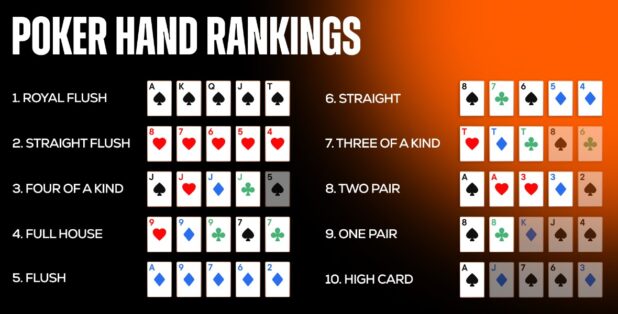The game of poker is not simply about the cards in one’s possession but rather understanding the value and rank of these cards.
In this article, we will unravel the hierarchy of poker hands, a paramount aspect of the game that significantly contributes to your success.
Table of Contents
The Basics of Poker Hands

Poker is a strategy-driven card game that calls for a comprehensive understanding of card ranks. The game comprises various types of hands, each holding a different value.
With a firm grasp of the hierarchy, you can outsmart your opponents and bring the odds in your favor.
The High Card
In poker, the high card is considered the lowest hand. When no other hand can be formed, the high card comes into play.
Usually, this situation happens when the five cards in hand cannot form a pair, flush, or straight, among other possible hands. Understanding this hand is the first step in comprehending the hierarchy.
Pair and Two Pair
Following the high card, the next higher hand in the poker hierarchy is the pair. A pair is a hand consisting of two cards of the same rank and three unrelated cards.
The two pair, however, consists of two different pairs and a fifth unrelated card. These hands offer a bit more in terms of potential, and comprehending their usage is key to mastering the game.
The Mid-Tier Poker Hands

As we continue to climb the poker hand hierarchy, we encounter more valuable hands.
Three of a Kind and Straight
Three of a Kind is a poker hand that consists of three cards of the same rank and two unrelated cards. Meanwhile, a Straight consists of five cards in numerical sequence, regardless of their suit. With these hands, players can begin to create effective strategies to outplay their opponents.
Flush and Full House
A Flush is composed of five cards from the same suit, regardless of their numerical order. In contrast, a Full House consists of a pair and three of a kind in the same hand. Understanding the nuances of these hands can be instrumental in making decisions during the game.
The Top-Tier Poker Hands

As we ascend to the top of the hierarchy, the hands increase in rarity and potential.
Four of a Kind and Straight Flush
Four of a Kind consists of four cards of the same rank and one unrelated card. On the other hand, a Straight Flush is made up of five cards of the same suit in numerical order. These hands are highly coveted and can potentially turn the tables in your favor.
The Royal Flush
The highest hand in poker is the Royal Flush. This hand includes an Ace, King, Queen, Jack, and Ten of the same suit. Possessing this hand is a guaranteed victory, as no other hand can trump it. The Royal Flush is a clear manifestation of the card rank hierarchy in poker.
The Importance of Understanding Poker Hands

Knowledge of poker hands is instrumental for success in the game. Without a firm understanding of the hierarchy, one would simply be playing blind, depending heavily on luck. Knowing what each hand represents and how it compares to others in the hierarchy is the first step toward strategic gameplay.
Utilizing Your Poker Hand Knowledge
Learning poker hands and their hierarchy is only the beginning. The real challenge lies in applying this knowledge during the game. When you have a good grasp of the poker hand hierarchy, you can make informed decisions.
Whether you decide to fold, call, or raise can hinge entirely on your understanding of the value of your hand versus the potential hands of your opponents.
Understanding the poker hand hierarchy can also aid you in reading your opponents. For instance, their betting patterns can hint at the hand they might possess. By comparing that possibility with your hand, you can strategize your moves accordingly.
Tips for Enhancing Your Poker Hand Knowledge

Understanding the hierarchy of poker hands is a continual learning process. It goes beyond memorizing the hands – it is about understanding the dynamics of the game. Here are a few tips to enhance your poker hand knowledge:
Practice Consistently
Consistent practice is key to reinforcing your understanding of poker hands. By playing poker regularly, you’ll be able to apply your knowledge in real time, which can deepen your understanding of the game.
Study and Learn from Others
Observing how other players handle their hands can also be a great learning experience. Analyze their strategies and think about why they made certain decisions. This can provide you with new perspectives and strategies to consider in your gameplay.
Review Poker Hand Rankings Regularly
It might seem unnecessary once you’ve memorized your hands, but frequent reviews can solidify your knowledge and keep it fresh. This could be particularly useful when learning about more complex hands.
The Bottom Line
Mastering the hierarchy of poker hands requires time, patience, and practice. For a comprehensive list of poker hands ranked, consider referring to reliable sources online.
Remember, understanding the hierarchy is just a portion of your journey in the fascinating universe of poker. It’s the combination of knowledge, strategy, and a bit of luck that will eventually lead you to success.
 World Magazine 2024
World Magazine 2024






